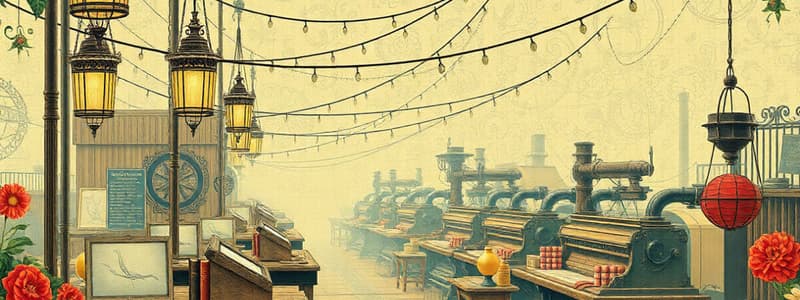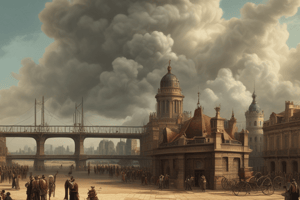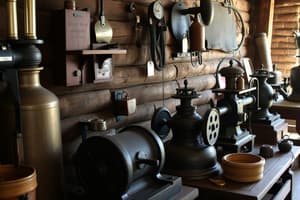Podcast
Questions and Answers
Which of the following best describes the relationship between the invention of the cotton gin and the prevalence of slavery in the United States?
Which of the following best describes the relationship between the invention of the cotton gin and the prevalence of slavery in the United States?
- The cotton gin had no impact on the prevalence of slavery, as slavery was already declining due to moral concerns.
- The cotton gin decreased the demand for cotton, leading to an increase in other types of agriculture that did not rely on slavery.
- The cotton gin increased the demand for cotton, which in turn expanded and entrenched the system of slavery in the U.S. (correct)
- The cotton gin directly led to the abolition of slavery by decreasing the need for manual labor.
How did the Enclosure Acts primarily contribute to the growth of the Industrial Revolution?
How did the Enclosure Acts primarily contribute to the growth of the Industrial Revolution?
- By promoting crop rotation techniques that increased agricultural productivity and reduced the need for labor.
- By establishing regulations that improved working conditions in rural agricultural settings.
- By providing financial assistance to small farmers, enabling them to invest in new technologies.
- By consolidating land ownership, leading dispossessed farmers to seek employment in urban factories. (correct)
Which of the following statements best explains the impact of James Watt's steam engine on the Industrial Revolution?
Which of the following statements best explains the impact of James Watt's steam engine on the Industrial Revolution?
- It improved agricultural output by automating the planting and harvesting of crops.
- It offered a reliable power source not dependent on water, enabling factories to be located anywhere, revolutionizing production. (correct)
- It provided a portable power that significantly improved transportation networks across Britain.
- It improved the efficiency of textile production by automating the process of weaving cloth.
What was the most significant consequence of the shift from the cottage industry to factory-based production during the Industrial Revolution?
What was the most significant consequence of the shift from the cottage industry to factory-based production during the Industrial Revolution?
Why was coal mining crucial to the growth of industries during the Industrial Revolution?
Why was coal mining crucial to the growth of industries during the Industrial Revolution?
What inference can be made about the working conditions in factories and mines during the Industrial Revolution, based on the information provided?
What inference can be made about the working conditions in factories and mines during the Industrial Revolution, based on the information provided?
Which of the following represents a direct consequence of agricultural innovations like the seed drill and crop rotation during the Industrial Revolution?
Which of the following represents a direct consequence of agricultural innovations like the seed drill and crop rotation during the Industrial Revolution?
How did the inventions of the Flying Shuttle, Spinning Jenny, and Water Frame collectively contribute to the Industrial Revolution?
How did the inventions of the Flying Shuttle, Spinning Jenny, and Water Frame collectively contribute to the Industrial Revolution?
Which of the following scenarios best exemplifies a 'proxy war' during the Cold War?
Which of the following scenarios best exemplifies a 'proxy war' during the Cold War?
How did differing ideologies contribute to the Cold War tensions?
How did differing ideologies contribute to the Cold War tensions?
What was the primary intention behind the USSR's desire for 'buffer states' in Eastern Europe?
What was the primary intention behind the USSR's desire for 'buffer states' in Eastern Europe?
What was the significance of the USA revealing its atomic bomb to the world without informing the USSR during the Potsdam Conference?
What was the significance of the USA revealing its atomic bomb to the world without informing the USSR during the Potsdam Conference?
Which decision made at the Yalta Conference ultimately contributed to escalating Cold War tensions?
Which decision made at the Yalta Conference ultimately contributed to escalating Cold War tensions?
What was the long-term impact of the arms race between the USA and the USSR during the Cold War?
What was the long-term impact of the arms race between the USA and the USSR during the Cold War?
How did the differing views on Germany's future contribute to the emerging Cold War?
How did the differing views on Germany's future contribute to the emerging Cold War?
What was the role of propaganda during the Cold War?
What was the role of propaganda during the Cold War?
Which of the following best describes the effect of the Cold War on global politics?
Which of the following best describes the effect of the Cold War on global politics?
Which of the following is an example of how the Cold War affected espionage tactics?
Which of the following is an example of how the Cold War affected espionage tactics?
Which of the following best reflects the intended impact of the Marshall Plan on post-World War II Europe?
Which of the following best reflects the intended impact of the Marshall Plan on post-World War II Europe?
What was the primary motivation behind Stalin's decision to implement the Berlin Blockade in 1948?
What was the primary motivation behind Stalin's decision to implement the Berlin Blockade in 1948?
How did the introduction of the Deutsche Mark in West Germany contribute to the Berlin Blockade?
How did the introduction of the Deutsche Mark in West Germany contribute to the Berlin Blockade?
What was the most significant outcome of the Berlin Airlift?
What was the most significant outcome of the Berlin Airlift?
Which of the following best describes the relationship between the Marshall Plan and the Molotov Plan?
Which of the following best describes the relationship between the Marshall Plan and the Molotov Plan?
How did the Iron Curtain Speech influence the trajectory of the early Cold War period?
How did the Iron Curtain Speech influence the trajectory of the early Cold War period?
What was the primary purpose of the formation of NATO in 1949?
What was the primary purpose of the formation of NATO in 1949?
In what way did the Soviet Union's actions in Eastern Europe contribute to the rising tensions of the Cold War?
In what way did the Soviet Union's actions in Eastern Europe contribute to the rising tensions of the Cold War?
How did events in Greece contribute to the emerging Cold War tensions between the USA and the USSR?
How did events in Greece contribute to the emerging Cold War tensions between the USA and the USSR?
What was the Warsaw Pact's primary strategic significance during the Cold War?
What was the Warsaw Pact's primary strategic significance during the Cold War?
Flashcards
Industrial Revolution
Industrial Revolution
A major shift from rural, agricultural societies to urban, industrial ones, starting in Great Britain in the 1700s.
Cottage Industry
Cottage Industry
The system of making goods at home using hand tools before factories.
Spinning Jenny
Spinning Jenny
Invented in 1764 by James Hargreaves; spun multiple threads at once, increasing textile production.
James Watt
James Watt
Signup and view all the flashcards
Eli Whitney
Eli Whitney
Signup and view all the flashcards
Textile Industry
Textile Industry
Signup and view all the flashcards
Enclosure Acts
Enclosure Acts
Signup and view all the flashcards
Crop Rotation
Crop Rotation
Signup and view all the flashcards
Iron Curtain Speech
Iron Curtain Speech
Signup and view all the flashcards
Containment Policy
Containment Policy
Signup and view all the flashcards
The Marshall Plan
The Marshall Plan
Signup and view all the flashcards
Molotov Plan
Molotov Plan
Signup and view all the flashcards
The Berlin Blockade
The Berlin Blockade
Signup and view all the flashcards
The Berlin Airlift
The Berlin Airlift
Signup and view all the flashcards
NATO
NATO
Signup and view all the flashcards
Warsaw Pact
Warsaw Pact
Signup and view all the flashcards
Deutsche Mark Introduction
Deutsche Mark Introduction
Signup and view all the flashcards
Ideological Conflict
Ideological Conflict
Signup and view all the flashcards
What was the Cold War?
What was the Cold War?
Signup and view all the flashcards
USA vs. USSR Ideologies
USA vs. USSR Ideologies
Signup and view all the flashcards
NATO and Warsaw Pact
NATO and Warsaw Pact
Signup and view all the flashcards
Proxy Wars
Proxy Wars
Signup and view all the flashcards
Capitalism
Capitalism
Signup and view all the flashcards
Communism
Communism
Signup and view all the flashcards
Domino Theory
Domino Theory
Signup and view all the flashcards
The Yalta Conference
The Yalta Conference
Signup and view all the flashcards
The Potsdam Conference
The Potsdam Conference
Signup and view all the flashcards
Arms Race
Arms Race
Signup and view all the flashcards
Study Notes
Changes in Society
- Urbanization occurred when people moved to cities for work
- Urban areas became overcrowded, leading to pollution
New Social Classes Emerge
- The upper class included factory owners, bankers, and merchants
- The middle class included managers, accountants, doctors, and lawyers
- Working class citizens were employed in factories and mines
Positive Effects of the Industrial Revolution
- New inventions and technology improved life
- There was an accumulated wealth for some
- The middle class grew
- There was more access to education
- Diets improved
- Cheaper goods and mass-produced products became available
Negative Effects of the Industrial Revolution
- Factory and mine workers faced harsh conditions
- Child labor became prevalent
- Pollution increased
- There was a large gap between the rich and the poor
- Tenement housing sprung up which was crowded and unsanitary for workers
New Economic Theories
- Capitalism means private ownership of business, free trade, and competition
- Adam Smith wrote The Wealth of Nations, defending capitalism
- Socialism means government control of business and wealth distribution
- Karl Marx wrote The Communist Manifesto, predicting workers would overthrow owners
Labor Unions & Reforms
- Workers organized into unions to demand better pay and conditions
- Strikes were used to pressure owners
- Laws were passed to reform child labor, limit hours, and improve safety
Studying That Suits You
Use AI to generate personalized quizzes and flashcards to suit your learning preferences.
Description
Explore the Industrial Revolution's origins in Great Britain during the 1700s, marked by a shift from rural life to factories. Learn about the cottage industry and the revolutionary inventions like the Flying Shuttle and Spinning Jenny that propelled the era.





